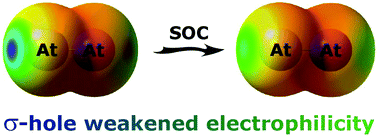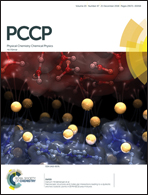Spin–orbit coupling as a probe to decipher halogen bonding†
Abstract
The nature of halogen-bond interactions is scrutinized from the perspective of astatine, the heaviest halogen element. Potentially the strongest halogen-bond donor, its ability is shown to be deeply affected by relativistic effects and especially by the spin–orbit coupling. Complexes between a series of XY dihalogens (X, Y = At, I, Br, Cl and F) and ammonia are studied with two-component relativistic quantum calculations, revealing that the spin–orbit interaction leads to a weaker halogen-bond donating ability of the diastatine species with respect to diiodine. In addition, the donating ability of the lighter halogen elements, iodine and bromine, in the AtI and AtBr species is more decreased by the spin–orbit coupling than that of astatine. This can only be rationalized from the evolution of a charge-transfer descriptor, the local electrophilicity ω+S,max, determined for the pre-reactive XY species. Finally, the investigation of the spin–orbit coupling effects by means of quantum chemical topology methods allows us to unveil the connection between the astatine propensity to form charge-shift bonds and the astatine ability to engage in halogen bonds.

- This article is part of the themed collection: 1st International Conference on Noncovalent Interactions


 Please wait while we load your content...
Please wait while we load your content...